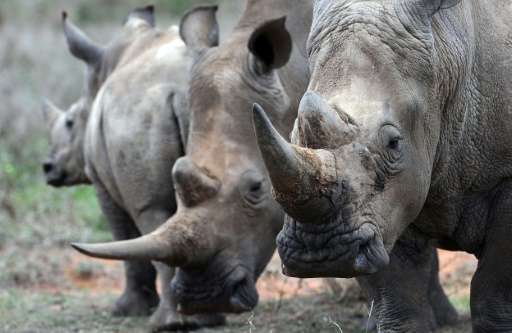Dung heaps are rhinos' Facebook: study

Rhinos signal gender, age, and sexual availability in their poo, said a study Wednesday which suggested mammals may use communal dung heaps as social networking sites.
It is well known that animals communicate via chemical messages transmitted in urine—think of dogs marking their territory—but the data-transmitting role of dung, another waste product, has been unclear.
A trio of scientists from South Africa and Germany extracted air from around dung pats of free-roaming white rhinos in the Hluhluwe-iMfolozi Park in KwaZulu-Natal, then analysed the scent in the lab.
The team recreated the signature dung smell of territorial males and of females in heat, then spread the synthetic odours around the park to mimic fresh poo deposits.
As expected, free-roaming territorial males, which are solitary, displayed different behaviours in response to distinct smells.
When the odour was that of an intruder bull, the males revisited the dung pile often to keep close tabs on the movements of a potential territorial rival, sometimes assuming a "vigilance posture".
Faced with the female-mimicking smell, the males spent a lot more time sniffing the odour advertising sexual readiness.
The results suggested that dung smells "do transmit key information," the researchers wrote in the journal Proceedings of the Royal Society B.
This included the depositor's age, sex, and for females, whether or not they are in heat.
"This is a vital step towards understanding why many mammals use communal defecation sites" called middens, said a Royal Society media summary.
"It is likely that such sites are used in the same way we use social networking—to 'read' the posts of others in their network and to leave posts for others."
The white or square-lipped rhinoceros is the largest species—the second largest land mammal after the elephant.
It grazes on short grasses, is extremely short-sighted and relies heavily on smells for information on its surroundings.
More information: Dung odours signal sex, age, territorial and oestrous state in white rhinos, Proceedings of the Royal Society B, rspb.royalsocietypublishing.or … .1098/rspb.2016.2376
Journal information: Proceedings of the Royal Society B
© 2017 AFP




















